


Preparation of a high explosive
With relatively simple means it is possible to prepare a chemical compound, which certainly can be classified as high explosive. This compound is a remarkably powerful and easy to detonate explosive. Even as a free flowing powder without any confinement and in quantities of just a few mg, it already detonates with a loud report. A quantity of 50 mg is sufficient to give a very loud BOOM, which hurts the ears, even when ignited in the open. The amount of light, produced by the explosion is very low. Sometimes, the light cannot be observed at all, sometimes there is a faint flash. But the sound is incredible. Tiny amounts give a very loud noise already.
 In
this experiment, a high explosive is made, which in itself is fairly stable and
can be stored safely, as long as the quantities do not exceed a few hundreds of
mg. Under distilled water, the solid explosive can be stored indefinitely
without the need to worry about premature explosion. When a quantity of over
approximately 10 mg of the mix is ignited, then a loud BANG is produced. Do not ignite quantities over 25 mg of this mix
in a small room inside. That may lead to serious damage to the ears.
In
this experiment, a high explosive is made, which in itself is fairly stable and
can be stored safely, as long as the quantities do not exceed a few hundreds of
mg. Under distilled water, the solid explosive can be stored indefinitely
without the need to worry about premature explosion. When a quantity of over
approximately 10 mg of the mix is ignited, then a loud BANG is produced. Do not ignite quantities over 25 mg of this mix
in a small room inside. That may lead to serious damage to the ears.
![]()
![]() Required
chemicals:
Required
chemicals:
-
nitric acid
-
silver nitrate (or silver metal of reasonable purity)
-
calcium carbide (or the impure stuff, called "carbid")
![]() Required
equipment:
Required
equipment:
-
small oil lamp or alcohol lamp
-
small metal spatula
-
small glass bottle, 50 to 100 ml
-
syringe, 50 or 60 ml
-
thin rubber or plastic tube with a length of approximately 50 cm
-
test tubes
![]() Safety:
Safety:
-
 Only ignite VERY small quantities of the reaction product.
Only ignite VERY small quantities of the reaction product. -
 Do not apply much friction and/or shock to the dry reaction product. That
may cause premature detonation!
Do not apply much friction and/or shock to the dry reaction product. That
may cause premature detonation! -
The small amount of smoke, produced in this experiment is somewhat toxic, due to its silver content. The amount is very low, but just to be on the safe side, avoid breathing it, and perform the explosion-part of the experiment in a ventilated room or outside.
-
Acetylene gas, formed in the reaction between water and calcium carbide, is very flammable.
-
Nitric acid is corrosive. The concentrated acid is very corrosive and any contact with the skin should be avoided.
-
When silver metal is dissolved in concentrated nitric acid, then copious amounts of brown nitrogen dioxide are formed. This is an insidiously toxic gas. Exposure to this gas may not lead to immediate adverse effects, but it may have delayed effects. This part of the experiment must be performed in a well-ventilated area or outside.
-
A solution of silver nitrate is corrosive and forms nasty black stains on the skin. These cannot be removed and only time can clear up the skin again.
![]() Disposal:
Disposal:
-
The remains of the reaction of calcium carbide with water can be flushed down the drain with a lot of water.
-
The liquid, decanted from the precipitate in the step where silver acetylide is separated from the acidic liquid, should be brought to a proper waste processing facility. It contains quite a lot of silver ions, which definitely should not be flushed down the drain.
-
No solid waste is produced during the explosion.
![]()
Preparation of an acidic solution of silver nitrate
![]() This
step must be done first. Easiest is to take a spatula full of silver nitrate and
dissolve this in a 5% to 10% solution of nitric acid. Another option is to take
half a gram of silver and dissolve this in 10 ml of approximately 50% nitric
acid. The solution of silver in nitric acid then needs to be diluted 5 times and
some of this solution is used as the solution which is used in the second step
of this experiment. The remaining part of the concentrated solution can be
stored for other experiments.
This
step must be done first. Easiest is to take a spatula full of silver nitrate and
dissolve this in a 5% to 10% solution of nitric acid. Another option is to take
half a gram of silver and dissolve this in 10 ml of approximately 50% nitric
acid. The solution of silver in nitric acid then needs to be diluted 5 times and
some of this solution is used as the solution which is used in the second step
of this experiment. The remaining part of the concentrated solution can be
stored for other experiments.
The solution of silver nitrate in nitric acid must be colorless. Especially when silver metal is used, then the solution may be colored, due to the presence of other metals, which were alloyed with the silver. Some alloying probably does no harm, but it is best to use as pure as available silver metal.
Preparation of some acetylene gas
![]() Fill the
glass bottle with tap water, until it is totally filled with water. Throw in the
small piece of calcium carbide (no powder, it must be a lump of at most 1 cm
diameter) and immediately LOOSELY cap the glass bottle and keep it upside down
in a tub, filled with water. The gas, produced by the calcium carbide presses
the water out of the bottle and the bottle is filled with gas.
Fill the
glass bottle with tap water, until it is totally filled with water. Throw in the
small piece of calcium carbide (no powder, it must be a lump of at most 1 cm
diameter) and immediately LOOSELY cap the glass bottle and keep it upside down
in a tub, filled with water. The gas, produced by the calcium carbide presses
the water out of the bottle and the bottle is filled with gas.
![]() Take the syringe and suck in 50 to 60 ml of gas from the
glass bottle, while the glass bottle is still upside down under water. Try to
avoid getting water from the bottle in the syringe. That water is dirty and
contains all kinds of solid particles from the calcium carbide.
Take the syringe and suck in 50 to 60 ml of gas from the
glass bottle, while the glass bottle is still upside down under water. Try to
avoid getting water from the bottle in the syringe. That water is dirty and
contains all kinds of solid particles from the calcium carbide.
Preparation of the silver acetylide
Important: Use distilled water in all steps, where silver salts are manipulated. With tap water a lot of chloride precipitate and a lot of turbidity is produced, which adversely affects the outcome of this experiment.
![]() Preparing of the silver acetylide is remarkably easy. Just
take the syringe with acetylene gas and very slowly bubble all of the gas
through the acidic silver nitrate solution. Try to keep the bubbles as small as
possible. One can press the small tube firmly against the bottom of the test
tube, such that more small bubbles are produced. If the bubbling of acetylene
gas is done too fast, then almost all gas just bubbles through the liquid and
most is lost into the air. As a guideline, take 3 to 5 minutes for pressing all
gas of the syringe into the silver solution.
Preparing of the silver acetylide is remarkably easy. Just
take the syringe with acetylene gas and very slowly bubble all of the gas
through the acidic silver nitrate solution. Try to keep the bubbles as small as
possible. One can press the small tube firmly against the bottom of the test
tube, such that more small bubbles are produced. If the bubbling of acetylene
gas is done too fast, then almost all gas just bubbles through the liquid and
most is lost into the air. As a guideline, take 3 to 5 minutes for pressing all
gas of the syringe into the silver solution.
While the gas is bubbled through the solution, a thick and coarse precipitate is formed. If very pure acetylene gas is used, then this precipitate is white. When impure acetylene gas is used from "carbid", then the precipitate is off-white, grey or light brown. The impure acetylene gas from "carbid" also contains some phosphine, traces of hydrogen sulfide and some organic contaminants. These contaminants make the precipitate off-white or even a little darker, they however, do not affect the explosive power at all.
![]() After
all gas is bubbled through the solution, let the precipitate settle at the
bottom. This should not take very long. Decant the liquid from the precipitate.
This liquid may still contain a lot of silver nitrate, and should not be flushed
down the drain. One could try to make a second batch of silver acetylide with
this liquid, otherwise collect it for proper disposal.
After
all gas is bubbled through the solution, let the precipitate settle at the
bottom. This should not take very long. Decant the liquid from the precipitate.
This liquid may still contain a lot of silver nitrate, and should not be flushed
down the drain. One could try to make a second batch of silver acetylide with
this liquid, otherwise collect it for proper disposal.
![]() Add a
lot of distilled water to the test tube, shake a few times and let the solid
settle again. Decant the distilled water again. This time, the liquid can be
flushed down the drain, it now only contains a small amount of silver ions.
Repeat this step another two times and finally let the solid settle at the
bottom in a test tube, filled with quite some distilled water.
Add a
lot of distilled water to the test tube, shake a few times and let the solid
settle again. Decant the distilled water again. This time, the liquid can be
flushed down the drain, it now only contains a small amount of silver ions.
Repeat this step another two times and finally let the solid settle at the
bottom in a test tube, filled with quite some distilled water.
![]()
The result: some silver acetylide
The final result of the precipitation and subsequent rinsing is shown here. It is a very coarse precipitate and also a very voluminous precipitate. Despite the voluminous nature of the precipitate, it settles very quickly at the bottom of the test tube.
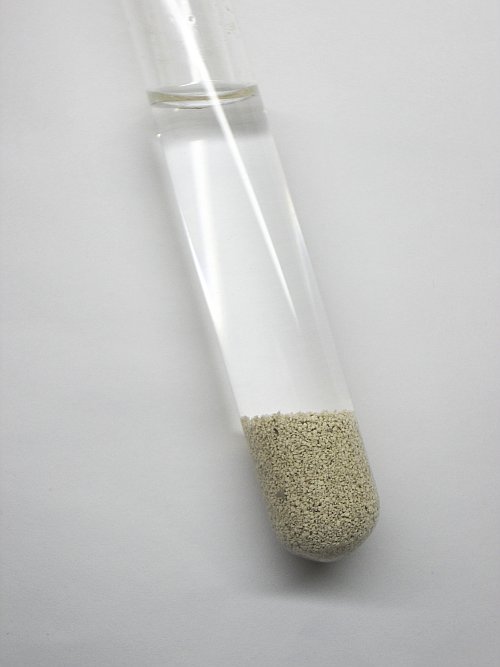
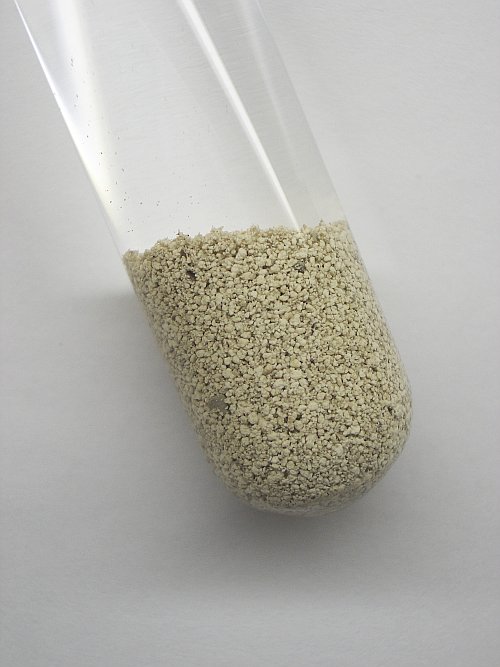
As this picture shows, the precipitate is not purely white. This is because here, the impure calcium carbide ("carbid") was used as the source of acetylene gas. The close-up of the precipitate nicely shows its granular structure and this also explains why it settles so easily. The precipitate is not slimy or flocculent at all and that is very pleasant.
When the precipitate is allowed to dry, then its volume
shrinks a lot. The final dry product only has 10% of the volume of the wet
precipitate. It also darkens somewhat on drying. The product was dried by
decanting all water, and putting all wet precipitate in a petri dish. The petri
dish is left on its own for a few days in the dark at room temperature. ![]() Do not speed up drying by heating this solid. That may lead to a detonation of
all solid at once. After drying, all of the solid was carefully
scraped together.
Do not speed up drying by heating this solid. That may lead to a detonation of
all solid at once. After drying, all of the solid was carefully
scraped together.
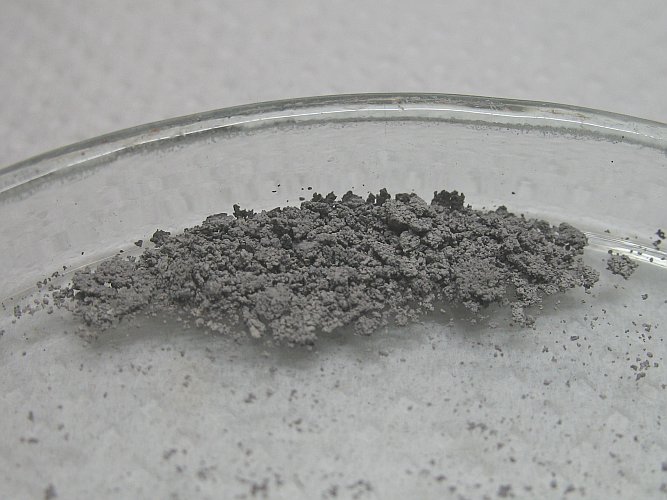
![]()
Detonating the silver acetylide
Making the material detonate is very easy. In fact it is so easy, that one should feel a little uncomfortable about it. The heat of a flame is sufficient to detonate it, one does not even need to be in the flame. Quite a long distance above the flame, it also detonates. Strong friction and shocks also can detonate this compound, so treat it carefully! Although the detonation of this compound is very impressive, when witnessed in real life, a video movie made of this detonation is not really impressive, due to the lack of light and smoke.
The detonation produces a strong shock wave and a loud noise, but hardly any light and smoke. The detonation also is very fast. With a frame rate of 60 frames per second, only one frame covers the detonation. Below, four frames of a movie are shown. These four frames nicely show the shock wave. One really has to put some effort in keeping the small spatula in the hand when the detonation occurs. If one is not prepared for the detonation, then the spatula will be blown out of the hand. The frames show that it is blown away and repositioned quickly, because it was held firmly.
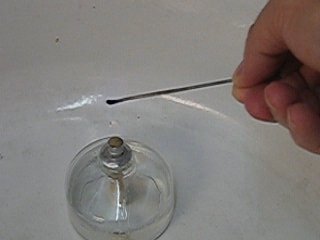
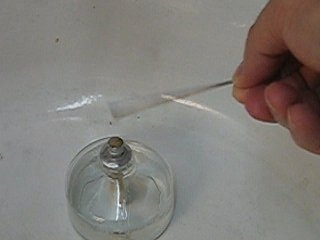
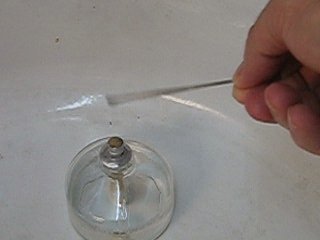
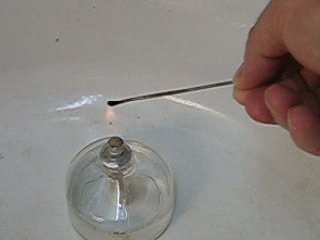
The upper left picture shows the situation before detonation, the upper right picture shows that the spatula is blown downwards by the shock wave and the two bottom frames show that the spatula is repositioned quickly. These four frames only cover 67 ms of time. This explosion was without any light and only with a very small amount of smoke.
Another sequence was performed and in that sequence, there was a brief flash of light and a little more smoke. In this sequence a somewhat larger amount of silver acetylide was used. These pictures are shown here and these are taken with 33 ms between two frames. These three frames cover 0.1 second of time.
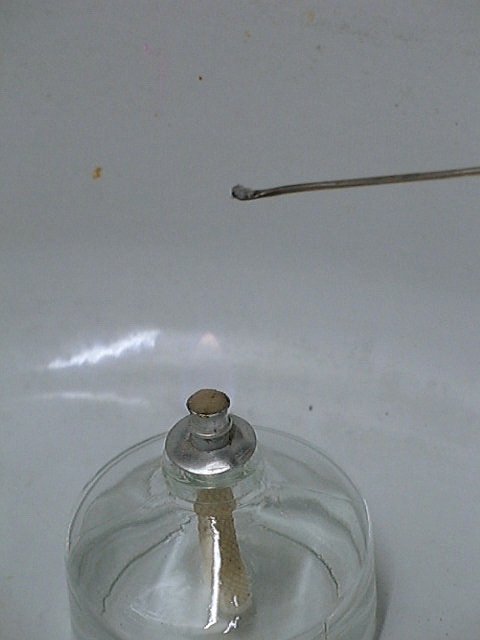
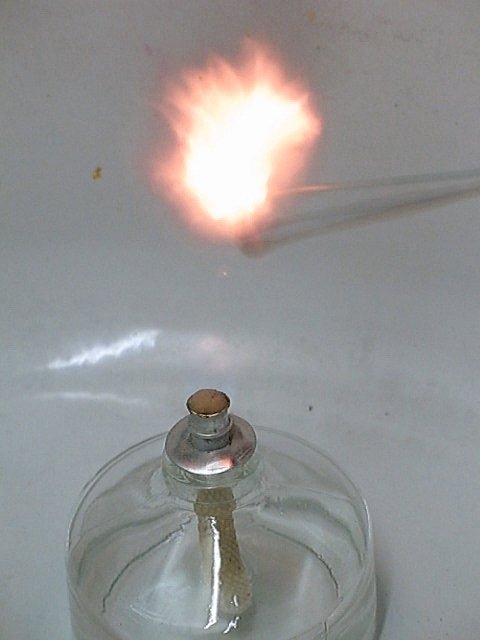
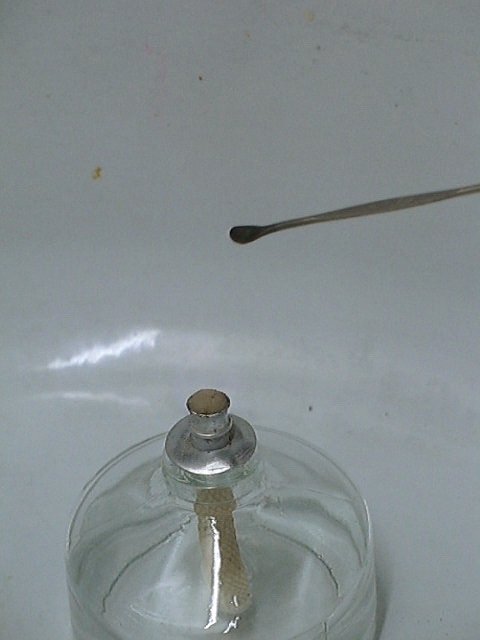
The top picture clearly shows the small pile of solid on the spatula, the middle picture shows the blast and the shockwave, the bottom picture shows that the spatula is empty and repositioned. The amount of light is not very high, only the flash area itself is over-exposed, the remaining part of the picture is not over-exposed. This is in great contrast to the experiment, performed with red phosporous and potassium periodate, where on ignition a very bright flash of light is produced.
Below, two pictures, taken from two other sequences are shown. Only the frame with the explosion is shown.
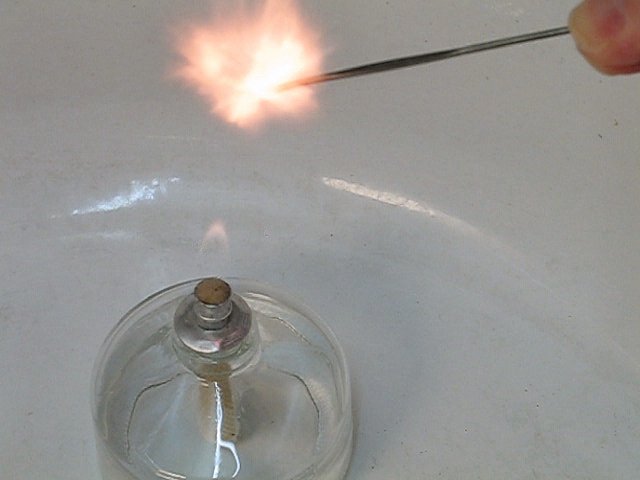
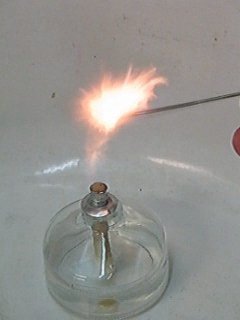
Finally, click here for a small animation of an explosion.
![]()
Discussion of results
The carbide ion, C22- is a very strong base. In its ionic form it cannot coexist with water. Any ionic metal carbide compound reacts with water, forming the covalent acetylene gas and the hydroxide of the metal. Calcium carbide reacts as follows:
CaC2(s) + 2H2O(l) → Ca(OH)2(s) + C2H2(g)
This reaction proceeds smoothly, non-violent, when a lump of calcium carbide is immersed in water.
The carbide, however, easily can form covalent bonds with some transition metals. The most stable one is the silver acetylide, but this also is possible with other transition metals.
With silver ions, the following reaction occurs:
2Ag+(aq) + C2H2(g) → 2H+(aq) + Ag2C2(s)
What is remarkable over here is that the silver ions are exchanged with the hydrogen atoms and that a very strong acid is formed from the compound C2H2, which itself is a very weak acid. With silver nitrate as the source of the silver ions, nitric acid is formed in solution.
In the experiment, however, the silver solution was strongly acidic already, it contained approximately 10% of nitric acid by weight. Under these conditions, the reaction results in an easier to separate precipitate. The Ag2C2(s) precipitate is quite slimy and flocculent and is not easily separated. With nitric acid present in solution, a double salt is produced, probably a mixed salt/covalent bonding type of compound, with the nitrate ion present as a real ion and the acetylide connected to the silver atoms in a mostly covalent bond. The net reaction equation is as follows:
3Ag+(aq) + C2H2(g) + NO3–(aq) → 2H+(aq) + Ag2C2·AgNO3(s)
The actual structure of Ag2C2·AgNO3 is not known to me as the author of this page and also the mechanism of this reaction with the acid is not really clear to me. Why does the acid result in the formation of a double salt? The acid itself is not used in this formation, even more acid is formed.
The double salt is more stable on storage and less sensitive, but it also is more powerful. This can be explained, because it now also has the oxidizer present in the same compound.